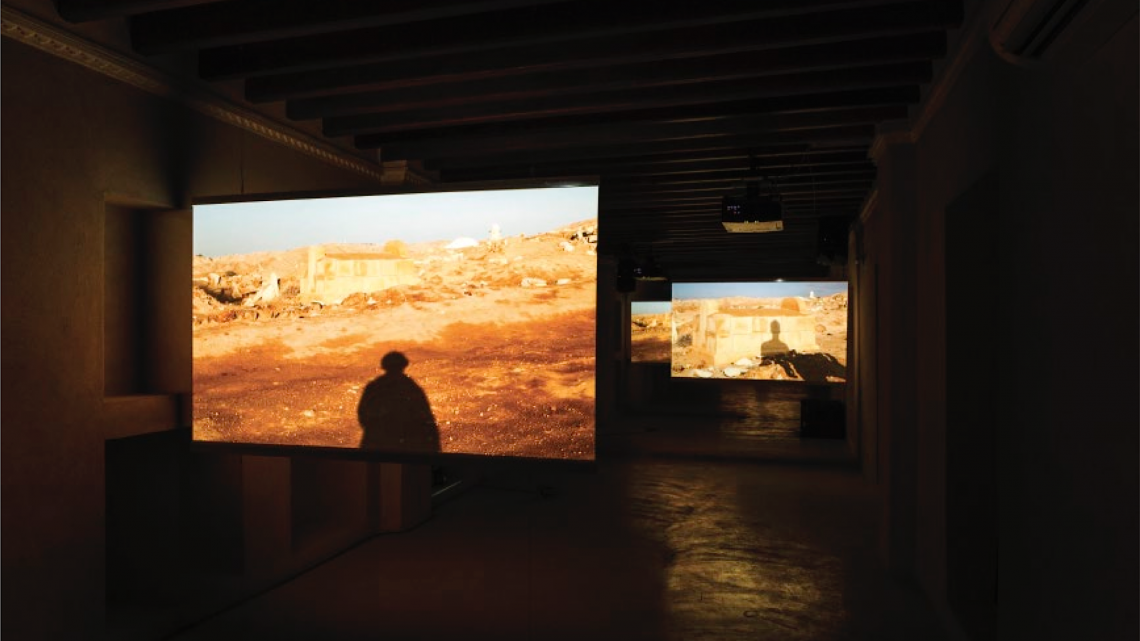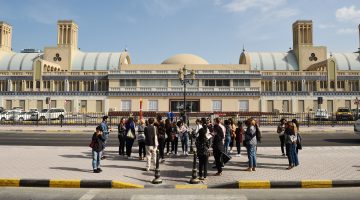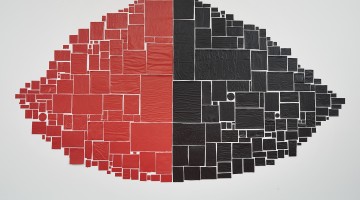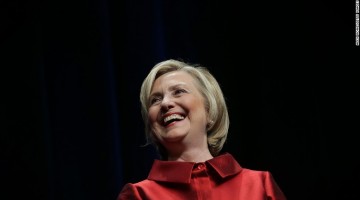At first sight, the city is nowhere as inebriating as the neighboring Dubai, with its maximalist now-iconic skyline, particularly sugarcoated for the Art Week and concomitant Art Dubai, the city’s glamorous fair with branded Maseratis and global ambitions. Sharjah, some twenty kilometers north of Dubai, belongs to a different species. An ancient port and early human settlement, Sharjah is rather non-descript in nature, and at times it feels as if it was left unfinished, but it is often punctuated by the strange monumentality of skyscrapers. Yet, unlike most of Dubai, there is a topography at the ground level: people, movement, and more people.
A small absolute monarchy that is part of this rather new federation known as the United Arab Emirates, Sharjah is fundamentally conservative, but beset with global ambitions and less deep-pocketed than its neighbors. Sharjah’s enlightened royal family has been on a decades-long mission to become the Arab world’s contemporary art hub. Home to the Sharjah Art Foundation, one of the Arab world’s most distinguished art institutions, the city-emirate is itself a myriad of contradictions and question marks that highlight not only the highly complex role that contemporary art plays in global geo-politics but also in the dynamics of capital and globalization.
With the Sharjah Art Foundation at the forefront, headed by a member of the royal family, the city hosts the now-renowned, albeit polemic, biennial and a number of museums and institutions mostly built from scratch around small collections, which simultaneously reflect limited resources, long-term interests, and a grassroots approach; at the polar opposite of Abu Dhabi’s frenzied international art collection and exhibition and Dubai’s share of the region’s art market.
Reputed to be the federation’s most conservative emirate, the question arises in Sharjah about the freedom necessary to produce relevant artwork and discuss broader issues affecting artistic practices in a turbulent region. The question is not in vain; back in 2011, the artistic director of the biennial was sacked over an artwork on public display that was considered offensive.
And where does this conversation even start? Clearly, the discussion about art in the Gulf is fraught with difficulties. Many of the Gulf defenders are public relations specialists whose goals and opinions are even less clear than the ones of those hiring them. On the other hand, those who denounce the growth of a local artistic scene and proclaim it to be illegitimate—however well meaning they may be—are openly ignorant about the region and badly misinformed about the horrible travesty of the industry that art has become since the 1990s, of which certain trends in the Gulf region are a standardized global response and not necessarily born of a local structure.
The atrocious architectures of inequality, the shameless corporatism involved in transnational migrant labor, and the prevalent weak models of citizenship, among others, were by no means invented in the Gulf and belong to the degenerate dynamics of modern crony capitalism. If new states were to be formed tomorrow anywhere in the world, this is exactly what they would look like because the current economic model simply doesn’t allow for a body politic independent of free markets. But this is not to say that there is no need for a direct engagement with the Gulf countries, in particular the U.A.E., regarding the future of these phenomena in the social realm and what they can possibly mean for art and artists.
Something of the sort takes place in The Past, the Present, the Possible, the title and theme of the 12th Sharjah Biennial proposed by curator Eungie Joo, but always in oblique, indirect, accidental, and ultimately inconclusive manners. The assumption today is that biennials offer only two possible models: a closed and specific research question that is deployed in order to produce an aesthetically controlled and coherent show, or a very broad theme where risks are to be taken and the results are not always as exciting as one would expect.
Eungie Joo, consistent with other curators at the margins of the big art world (São Paulo, Istanbul, Gwangju), has fortunately chosen to take the risk of a very broad theme at the expense of uncertainty and confusion. The exaggerated degree of overspecialization in the art world has led to a situation in which none of the big questions of art matter anymore, so that art is excluded from the expanded field of politics and the social. Not unlike the academic disciplines to which art is related—philosophy, anthropology, literary criticism—the current focus of the contemporary is on the production of meta-art, or the art world’s equivalent of secondary literature: post-conceptual, post-Internet, post-relational, etc. The problem (and a particularly interesting one) with a broad theme is that it clashes immediately with the Eurocentric, exhibition focused model of the biennial once it is removed from the safe confines of Western academic art and the deep pockets of the state.
Maybe it’s also true that biennials are obsolete now. First there is the upbeat game of art fairs with their commissions and programs catering to both young audiences and professionals, and then there are the collector-centric mechanisms and the political whitewashing, from Istanbul to Bogotá to Kochi. And then there is the big money.
At the heart of Joo’s concept, beyond the very egocentric problems of meta-art, is a skilled renegotiation and profound articulation of today’s most wide-ranging cultural problem: what happened to the imagination of the future?
“As the emirate’s future history is written through urban development, heritage site-restoration, interdependent transnational economies, and a diverse everyday culture, Sharjah Biennial 12: The Past, the Present, the Possible, has invited fifty-one artists and groups to help us imagine and reflect upon its ambitions, possibilities, and being,” writes Joo in her statement. This is a rather porous and very vague description of the monumental enterprise of mapping the contour of a future that is being written as we speak. These young polities, born out of colonialism but without a nation-state to speak of that can amalgamate them, are a strange and loose combination of diverging fragments. It is but the solidification of these fragments into an imagined common past that stabilizes the future as a common project, yet the alarming discontent with the present has altered the grammar of this process.
The difficulty with this model of temporality is that it permanently delays the future in order to prevent all risks and uncertainties. As the predictability of risk recedes more and more into the wasteland of complexity systems and the entropy of mass media and big data, the political self becomes further obscured and a project of writing the future through the past becomes questionable as it is always anchored in notions of history and heritage, potentially embedded in the reactionary psychology of caution. These new histories emerge as obstacles for the political production of the same globalization fantasies that claim to enable the rewriting of the future as an open and dynamic structure.
Impossible to conceive of this biennial as an exhibition or as an academic exercise, Sharjah 12 is a galaxy of dispersions and uncertainties, that while conveying the condition of our time and of “times” in general, it is experienced as a sequence of imbalances or gaps; it is difficult to stand on any specific place, to adopt a point of view, to cross from one point to another, without stumbling. This isn’t necessarily a metaphor: the navigation between the different spaces of the Sharjah Art Foundation is akin to entering a labyrinth of invisibilities superimposed one atop another, without clear direction, in the confusion between constructed and derelict sites, staged venues, and real places, all of them operating as an abstract space.
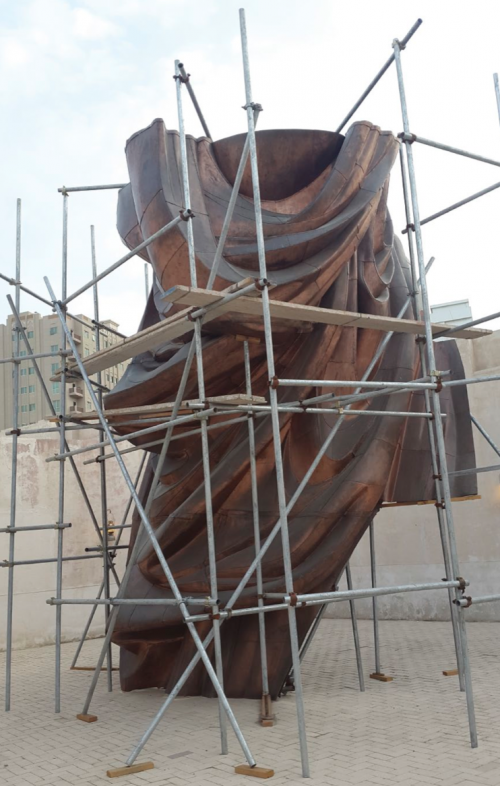
Danh Vō, We The People (detail), 2011-14. Copper, wood, metal. Variable dimensions. Photograph by Arie Amaya-Akkermans.
Is Sharjah the biennial or is it just the site thereof? In a place where the concept of the public domain is so theoretical and largely limited to commerce, moving between temporalities requires more immersion and concentration than expected from a large show. One of the biennial’s iconic pieces, Danh Vō’s We The People (2010), is a full-scale reproduction of the Statue of Liberty, fabricated in China replicating the original technique, out of which only thirteen pieces (the original number is about two hundred and fifty) are assembled here. Vō provides extensive commentary on the processes of function, value, and transformation that are part and parcel of the delusion of globalization and relies on the semantic ubiquity of symbolic narratives that are nowadays articulated by commerce. Can freedom be assembled into boxes piecemeal and transported to the post-colonial world? Of course it can—this is modernity as a take-away service.
Rayyane Tabet’s signature work Steel Rings (2013) is also an all-time popular piece that strongly echoes in the region. In 1946, the Trans-Arabian Pipeline Company established a long pipeline to transport oil by land from Saudi Arabia to Lebanon at the height of its republican golden age, and is represented here as an intersection between politics, design, and history. It was later abandoned in 1983 when the company was dissolved during the Lebanese Civil War and the different armed conflicts that engulfed the region, leaving the infrastructure behind and intact. The steel rings representing the first sixty kilometers of the pipeline from its point of origin in Saudi Arabia, manufactured to the same dimensions of the original pipeline, are engraved with the distance from the pipeline’s source and geographical coordinates.
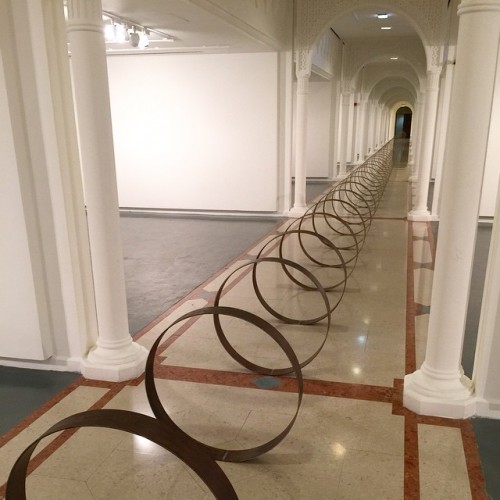
Rayyane Tabet, Steel Rings, 2013. Rolled engraved steel. 31 x 4 x .25 inches (each). Courtesy Sfeir-Semler Gallery, Beirut and Hamburg, and the artist.
These works, albeit magnificent, demonstrate the difficult open-endedness of a concept such as Joo’s, an attempt to tackle something so deformed and contentious as our relationship to future modes of temporality; for what is embodied here is more movement than time. Is this movement a time orientation? The beginning and end of the Trans-Arabian Pipeline coincides with the birth and death of Arab nationalism and the disenchantment with the modern project, to the same degree that V’s (and this work is absolutely central to the conception of the biennial) embodies the twisted realities of foreign policies dictated by corporatism.
Brazilian artists Cinthia Marcelle and Jac Leirner, whose sensibilities are very much in tune with those of the U.A.E., are here charged with a legacy of social realism and political contestation. Each excavates the quotients of the global puzzle that defines emerging markets: labor and money. Cynthia Marcelle’s installation At the Risk of the Real (2015), produced onsite, engages with processes of labor and industrial production with a relational aspect. Conceived as a construction site (the most iconic feature of the U.A.E.), the post-and-beam structure highlights the conditions of workers in the region through a system of sieves that sporadically obstruct the vision field. While very popular among critics, and certainly well accomplished, perhaps she could have focused less on the specific conditions of the Gulf as there is a need to spread the obvious: structural conditions associated with labor practices must be investigated as a part of a global mechanism that is not solely associated with piles of sand and construction sites in the Gulf. The poetic ready-mades of Leirner, including Todos Os Cem (1998), incorporate devaluated Brazilian bank notes from the 1980s and 1990s—an inflationary period that witnessed the collapse of currency before the generation of BRICS. Perhaps a repetitive sign of the times? Possibilities for a more balanced financial ecosystem become shakier and shakier until they potentially disappear into a mathematical operation or a gesture.
The three rooms in the Beit Al Serkal building, occupied with the work of Palestinian artists Basel Abbas and Ruanne Abou-Rahme, seem to have the concept of the biennial tailored around them, rather than the other way around. The Incidental Insurgents (2012–2015), an installation in three parts across audio, video, archival material, and text, is using some political markers as metaphors and cultural platforms to qualitatively investigate the future. How can a future start from different beginnings? How do multiple futures coalesce and what do they say about our here-and-now? Exploring the radical disillusionment with the modern project at the heart of two centuries of Arab history, the artists propose to examine the traces of those histories as monads that can ignite time and begin something again, but for the first time. A mesmerizing visual study of possibilities and reality-belief, The Incidental Insurgents is the most significant work present in Sharjah 12.
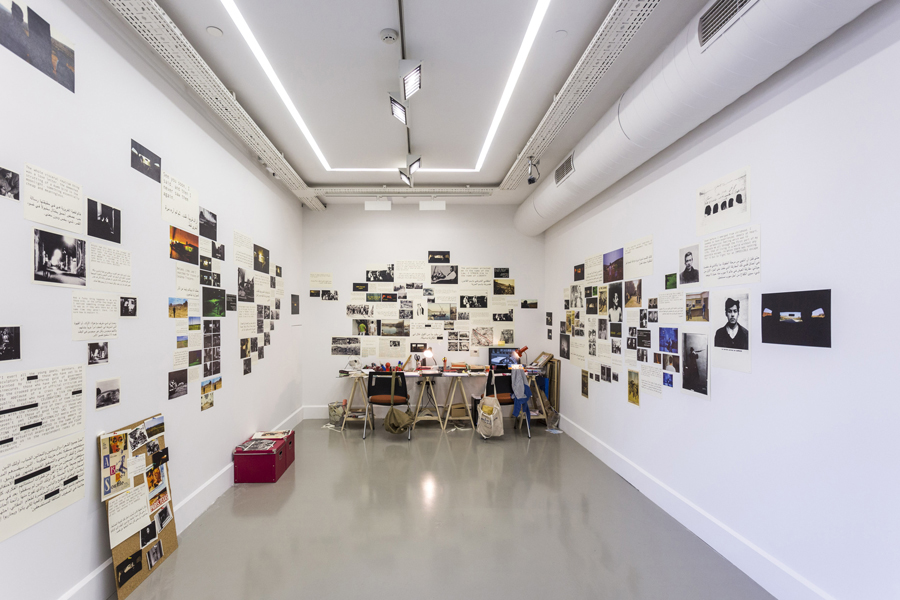
Basel Abbas and Ruanne Abou-Rahme, The Incidental Insurgents (Parts 1-3), 2012-2015. Mixed media installation. Courtesy of Carroll/Fletcher, London.
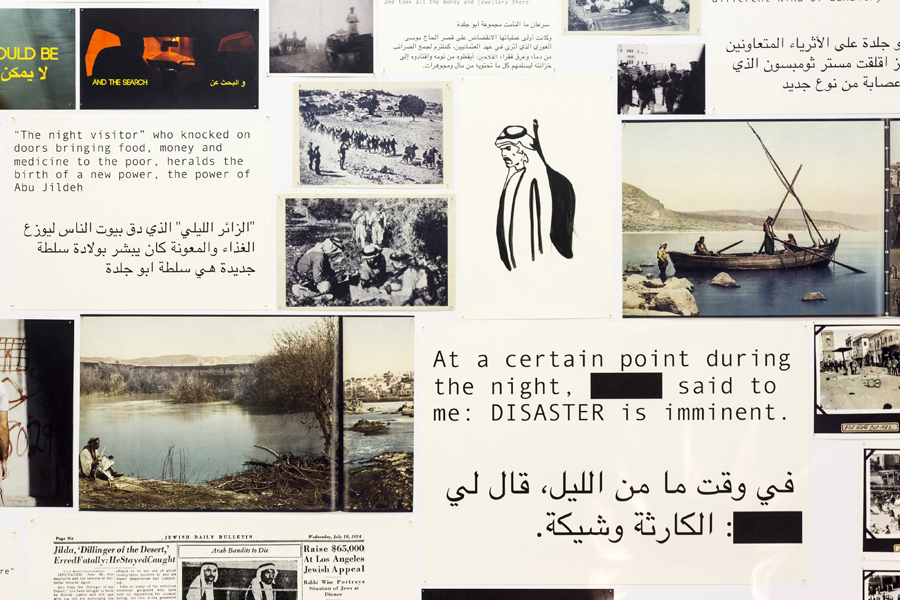
Basel Abbas and Ruanne Abou-Rahme, The Incidental Insurgents (Parts 1-3), 2012-2015. Mixed media installation. Courtesy of Carroll/Fletcher, London.
A very important part of this show, because of its engagement with modes of temporality, was a rare display of art from the modern period (or, actually, from overlapping periods). Modern art is for us, in a certain way, the last moment in cultural history that had a radical imagination of the future, either utopian or dystopian, that was driven by either the historicist belief in progress or the eschatological impetus, both of which imply a specific direction in time that is completely different from our current cul-de-sac. On the one hand, Saloua Raouda Choucair’s sculptures and Hasan Sharif’s conceptual works, both of them (in different generations) pioneering figures in abstract and conceptual art in the Arab world, present a set of preoccupations that seem absolutely relevant here: a constructivist and almost mathematical conception of art, a re-definition of the architectural, and a certain rigid formalism that distinguishes them altogether from the decorative arts. Choucair and Sharif, though radically different, do represent in their own time and place an incision into different possibilities of the not-yet-present.
For an interesting contrast, there is the first large-scale presentation of Korean art in the region, which is also representative of a transitional period between modern and contemporary art. Of particular interest were the works of Chung Chang-Sup from the 1970s–1990s—part of the Korean monochrome movement known as Dansaekhwa—which take traditional construction materials into abstraction and either accelerate or slow down points of contact between painting, material, surface, and representation. The reasons for the pieces being there (alongside Byron Kim and Beom Kim) are not particularly clear, but in the end it works out well and a number of different readings are possible.
These works, among others, stand out as having a particularly interesting connection to the proposal, either directly or casually, and though they never come together, there is a perpendicular thread that oscillates like a pendulum, undulating often towards one pole and leaving open gaps as traces behind. As in any presentation of this kind, there is a lot of exhibition pollution, namely work that is largely unrelated or occupying shelf space because of certain institutional connections that demand it for a variety of reasons, and in that respect Sharjah is not different from any of its more academic or experimental counterparts in the West.
But to study the possible futures—to lay them out, to propose a theory, to test them, or even to say anything about them—means to live without the safety net of a remote past where only myth is capable of engendering the real. In this strange urban space of Sharjah, both ancient and new, at the crossroads of different worlds no longer defined by geography and culture but by economy and class, one is constantly exposed to the threat of a depleted future that will throw us back into the past. Are we walking into the best of all possible futures or the worst of all possible pasts? This past, however promising and eternal it might be, is pregnant with precariousness. It has already been inflected by our own manmade world; an empty universe that is not a space of solace and redemption, but only that—empty space.
The promise of restoration has been broken, for as the cultural destruction in the broader Middle East at the hands of the self-proclaimed Islamic State has greatly demonstrated, the restoration will not lead us to wherever we were before Copernicus launched us into space. No, instead we will be right here again, in a world dominated by technological barbarism, violence, and profit, not much unlike the planet in which most people live nowadays, outside of our islands of privilege. Not unlike, but much worse. For this reason a theory of the possible futures, as long as it doesn’t lead to a glorious past, is the ethical and political imperative of our lived times. This is why Sharjah is something worth looking at.
